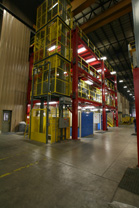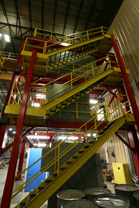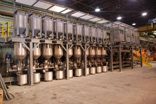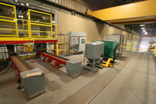Applicon designs ingredient batching systems for one to many ingredients, dry or liquid, fine powders to coarse lump. Regardless of the system configuration, ingredients can be delivered to the batching system by pneumatic or mechanical conveyor, or by IBC (bulk bag, portable bin, etc).
Micro / Minor Ingredients:
Micro Ingredients
The choice of feeder and extraction for micro ingredients is governed mostly by the ingredient characteristics, but also by the total batch size, batch frequency, and the type of batch delivery to downstream operations (blending, charging or injection, or packaging). The feeder and scale must be accurate, repeatable, and timely, the delivery downstream must be dependable and complete. Accurately dispensing a tiny dose of powder doesn't mean much, if it doesn't all arrive downstream. We design each system to insure that the micros get there.
Minor Ingredients
A minor ingredient might be 5 lb., or 500 lb., depending on the batch size being made. In either case, it is crucial to design the system and the scales to accurately make the minor weighment. Saving capital cost by weighing minors with the majors (for example, 50 lb. on a 10,000 lb. scale) sacrifices quality for up front savings; the accuracy of even the best 1,000 lb. scale will be very poor for a weighment that is only 10 lb.
Physical Arrangements:
Tower System
Used in multi-floor buildings or where high headroom is available. This design reduces the amount of conveying & re-conveying.
Linear System
Used where headroom is limited, or when there are many ingredients. Linear systems can be designed for access from one or both sides, and are the typical design for Bulk Bag and Portable Bin dispensing systems.
Carousel System
Often used where both headroom and floor width are limited. Carousels typically do not really take up less square footage, but can be used in corners or where limited aisle frontage is available.
Hybrid System
Tower, Linear or Carousel can be combined. For example, ten ingredients from FIBC or Pbin in linear format, combined with twenty minor ingredients in carousel format.
Add Weight versus Loss of Weight:
Loss-in-Weight
Continuous loss-in-weight is a valid design scheme where true continuous ratio metering is beneficial, such as in continuous compounding, and when there are only two to three constituents.
Batch loss-in-weight dispensing might be used to either save headroom, or to dispense multiple materials simultaneously.
Add Weight
Add weight, or gain-in-weight systems are the most common type of formulation system for dry bulk ingredients. This design, with sequential weighing to a common scale hopper, can be augmented with loss-in-weight for some ingredients.









